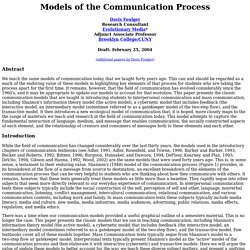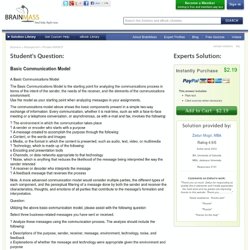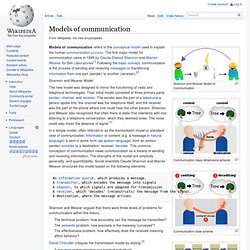

Models of the Communication Process. Davis Foulger Research Consultant Evolutionary Media* Adjunct Associate Professor Brooklyn College/CUNY Draft: February 25, 2004 (additional papers by Davis Foulger) Abstract We teach the same models of communication today that we taught forty years ago.

This can and should be regarded as a mark of the enduring value of these models in highlighting key elements of that process for students who are taking the process apart for the first time. Introduction While the field of communication has changed considerably over the last thirty years, the models used in the introductory chapters of communication textbooks (see Adler, 1991; Adler, Rosenfeld, and Towne, 1996; Barker and Barker, 1993; Becker and Roberts, 1992; Bittner, 1996; Burgoon, Hunsaker, and Dawson, 1994; DeFleur, Kearney, and Plax, 1993; DeVito, 1994; Gibson and Hanna, 1992; Wood, 2002) are the same models that were used forty years ago. Shannon's Model of the Communication Process An information source. References Adler, R. Notes: Basic Communication Model. A Basic Communications Model The Basic Communications Model is the starting point for analyzing the communications process in terms of the intent of the sender, the needs of the receiver, and the elements of the communications environment.

Use the model as your starting point when analyzing messages in your assignments. The communications model above shows the basic components present in a simple two-way exchange of information. Every communication, whether it is real-time, such as with a face-to-face meeting or a telephone conversation, or asynchronous, as with e-mail and fax, involves the following: ? Note. Question: Utilizing the above basic communication model, please assist with the following question Select three business-related messages you have sent or received. ?
O Descriptions of the purpose, sender, receiver, message, environment, technology, noise, and feedback o Explanations of whether the message and technology were appropriate given the environment and purpose ? The basic communication model diagram. Communication Models. Communication Models Although adapted and updated, much of the information in this lecture is derived from C.

David Mortensen, Communication: The Study of Human Communication (New York: McGraw-Hill Book Co., 1972), Chapter 2, “Communication Models.” A. What is a Model? 1. 2. 3. B. 1. Mortensen: “A good model is useful, then, in providing both general perspective and particular vantage points from which to ask questions and to interpret the raw stuff of observation. 2. Models also clarify the structure of complex events. 3. At another level models have heuristic value; that is, they provide new ways to conceive of hypothetical ideas and relationships. C. 1. “There is no denying that much of the work in designing communication models illustrates the oft-repeated charge that anything in human affairs which can be modeled is by definition too superficial to be given serious consideration.” Some, like Duhem’s (1954), believe there is no value in models at all: 2. 3.
Kaplan (1964): Models of communication. Shannon and Weaver Model of Communication Communication major dimensions scheme Communication code scheme Linear Communication Model Interactional Model of Communication Berlo's Sender-Message-Channel-Receiver Model of Communication Transactional Model of Communication Models of communication refers to the conceptual model used to explain the human communication process.

Shannon and Weaver Model.